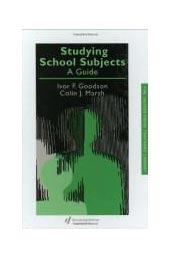Studying School Subjects: a guide
Conclusions, Complexities and Conjectures
The second hypothesis examined within the book relates to three major traditions discerned in school subjects: the academic, the utilitarian and the pedagogic. It was thought that an evolutionary profile of the school subjects under study would show a progressive movement away from stressing utilitarian and pedagogic versions of the subjects towards increasing promotion of more academic versions. We have already seen when discussing the nature of school subjects that sub-groups representing new geography, 'hard science' biology and examinable environmental studies, had come to be leading promoters of their subjects by the early 1970s. The process and rationale behind this outcome require fairly detailed understanding, representing as they do the culmination of a contest between a range of well-supported alternative definitions within each of the subjects.
The model of subject establishment towards a culminating 'academic' discipline was found to be closely applicable to both geography and biology. Once successfully promoted as an academic discipline the selection of the subject content is clearly considerably influenced 'by the judgement and practices of the specialist scholars in the field'. Subjects defined in this way, require a base of 'specialist scholars' working in universities to continue the definition and legitimation of disciplinary content.
The strategy for achieving this third stage received early recognition in geography. MacKinder's 1903 four-point plan provides an explicit statement of a subject aspiring to academic acceptance. The key to the strategy was the first point, the establishment of 'university Schools of Geographers where Geographers can be made'. To complete the control of the subject's identity, geography teaching and examination construction was to be placed in the hands only of teachers 'made' in the universities. The mediation between university and school was in geography, placed in the hands of the Geographical Association. The Association, founded in 1893, played a central role in the promotion of geography, since in its early days the subject was confined to idiosyncratic schools-based versions and had obtained a tentative place in only a few universities.
The close linkage between the growth in schools and the establishment of the subject elicits regular comment in the pages of 'Geography'. The President of the Geographical Association paid homage to 'fruits of inspired teaching' which have led to the 'intense and remarkable upsurge in the demand to read our subject in the universities'. The result has been 'the recognition of our subject's status among university disciplines together with the costly provision made available for its study'. The latter point shows the direct link between academic status and resources in our educational system: the triumph of the 'academic' tradition over the utilitarian and pedagogic traditions which played such a prominent party in geography's early days is to be partly understood in these terms.
